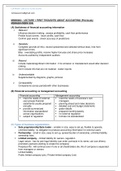Class notes
UCL MSIN0004 Revision Notes
- Course
- Institution
- Book
• 28-pages study notes for MSIN0004 Accounting for Business • Seller achieved a high 1st (88%) for this module • Summarized key points from both textbook and lecture slides • Includes diagrams, key definitions and important formulae • This set of study notes intend to serve as a quick rev...
[Show more]




